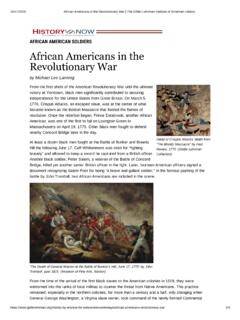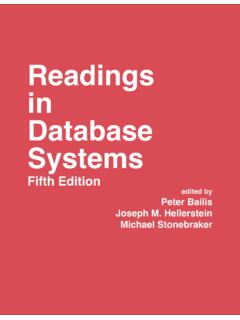Transcription of Data Modeling and Data Models The Importance of Data …
1 1 Chapter 2 Objectives: to understand Data Modeling and why data Models are important The basic data- Modeling building blocks What business rules are and how they influence database design How the major data Models evolved historically How data Models can be classified by level of abstractionCS275 Fall 20101 Introduction to Data Modeling Data Modeling reduces complexities of database design Designers, programmers, and end users see data in different ways Different views of same data lead to designs that do not reflect organization s operation Various degrees of data abstraction help reconcile varying views of same dataCS275 Fall 20102 Data Modeling and Data Models Model.
2 An abstraction of a real-world object or event Useful in understanding complexities of the real-world environment Data Models Relatively simple representations of complex real-world data structures Often graphical Creating a Data model is iterative and progressiveCS275 Fall 20103 The Importance of Data Models Facilitate interaction among the designer, the applications programmer, and the end user End users have different views and needs for data Data model organizes data for various users Data model is a conceptual model - an abstraction It s a graphical collection of logical constructs representing the data structure and relationships within the database.
3 Cannot draw required data out of the data model An implementation model would represent how the data are represented in the database. CS275 Fall 201042 Data Model Basic Building Blocks Terminology Entity: anything about which data are to be collected and stored Attribute: a characteristic of an entity Relationship: describes an association among entities One-to-many (1:M) relationship Many-to-many (M:N or M:M) relationship One-to-one (1:1) relationship Constraint: a restriction placed on the dataCS275 Fall 20105 Business Rules Descriptions of policies or principles within an organization Description of operations or procedures, to create/enforce actions within an organization s environment Must be in writing and kept up to date Must be easy to understand and widely disseminated Sometimes externally defined, government regulations.
4 These describe characteristics of data as viewed by the companyCS275 Fall 20106 Discovering Business Rules Sources of business rules: Company managers Policy makers Department managers Written documentation Procedures Standards Operations manuals Direct interviews with end users Always verify sources of informationCS275 Fall 20107 Importance of Business Rules Standardize company s view of data Useful as a communications tool between users and designers Allows the designer to understand the nature, role, and scope of data understand business processes develop appropriate relationship participation rules and constraints Promotes the creation of an accurate data model CS275 Fall 201083 Translating Business Rules into Data Model Components Generally, nouns translate into entities Verbs translate into relationships among entities Relationships are bidirectional Two questions to identify the relationship type: How many instances of B are related to one instance of A?
5 How many instances of A are related to one instance of B?CS275 Fall 20109 Naming Conventions Naming occurs during translation of business rules to data model components Names should make the object unique and distinguishable from other objects Names should also be descriptive of objects in the environment and be familiar to users Proper naming: Facilitates communication between parties Promotes self-documentationCS275 Fall 201010 Evolution of Data Implementation Models Hierarchical Logically represented by an upside down tree Each parent can have many children Each child has only one parent Network Relational Object oriented Hybrid.
6 XMLCS275 Fall 201011 The Hierarchical Model The hierarchical model was developed in the 1960s to manage large amounts of data for manufacturing projects Basic logical structure is represented by an upside-down tree Hierarchical structure contains levels or segments Segment analogous to a record type Set of one-to-many relationships between segments Example manufacturing a car from components (a,b,or c), each made of subassemblies (1,2,or3), each having parts (x,y,&z) ..(tree structure)CS275 Fall 2010124 Hierarchical StructureCS275 Fall 201013 Hierarchical Structure Each parent can have many children Each child has only one parent Tree is defined by path that traces parent segments to child segments, beginning from the left Hierarchical path Ordered sequencing of segments tracing hierarchical structure Preorder traversal or hierarchic sequence Left-list pathCS275 Fall 201014 The Hierarchical Model GUAM (Generalized Update Access Method)
7 Based on the recognition that the many smaller parts would come together as components of still larger components Information Management System (IMS) World s leading mainframe hierarchical database system in the 1970s and early 1980s TCDMS/ADABAS jointly developed by IBM and Lane County CS275 Fall 201015 The Hierarchical Model Advantages Conceptual simplicity Database security Data independence Database integrity Efficiency Disadvantages Complex implementation Difficult to manage Lacks structural independence Complex applications programming and use Implementation limitations Lack of standardsCS275 Fall 2010165 The Network Model The network model was
8 Created to represent complex data relationships more effectively than the hierarchical model Improves database performance Imposes a database standard Represent complex data relationships more effectively such as child w/ multiple parents Conference on Data Systems Languages (CODASYL) American National Standards Institute (ANSI) Database Task Group (DBTG)CS275 Fall 201017 The Network Model Collection of records in 1:M relationships A Set is a relationship and composed of two record types: Owner: Equialentto the hierarchical model s parent Member: Equivalent to the hierarchical model s childCS275 Fall 201018 The Network Model Components Concepts still used today: Schema:Conceptual organization of entire database as viewed by the database administrator Subschema: Database portion seen by the application programs Data management language (DML): Defines the environment in which data can be managed Data definition language (DDL).
9 Enables the administrator to define the schema componentsCS275 Fall 201019 The Network Model Advantages: Conformance to standards Handled more relationship types Data access flexibility Disadvantages of the network model: System complexity Lack of ad hoc query capability placed burden on programmers to generate code for reports Structural change in the database could produce havoc in all application programsCS275 Fall 2010206 The Relational Model Developed by Codd (IBM) in 1970 Relational Models were considered impractical in the 1970 s.
10 Model was conceptually simple at expense of computer overhead Relational table is purely logical structure How data are physically stored in the database is of no concern to the user or the designer This concept is the source of a real database revolutionCS275 Fall 201021 Relational Table A Relational table is a purely logical structure How data are physically stored in the database is of no concern to the user or the designer. Stores a collection of related entities Resembles a file Table (relations) Matrix consisting of a series of row/column intersections Each row in a relation is called a tuple Related to each other by sharing a common entity characteristicCS275 Fall 201022 The Relational Model Components Relational data management system (RDBMS) Performs same functions provided by hierarchical model, but hides complexity from the user

















